Training Meeting Minutes Samples
-
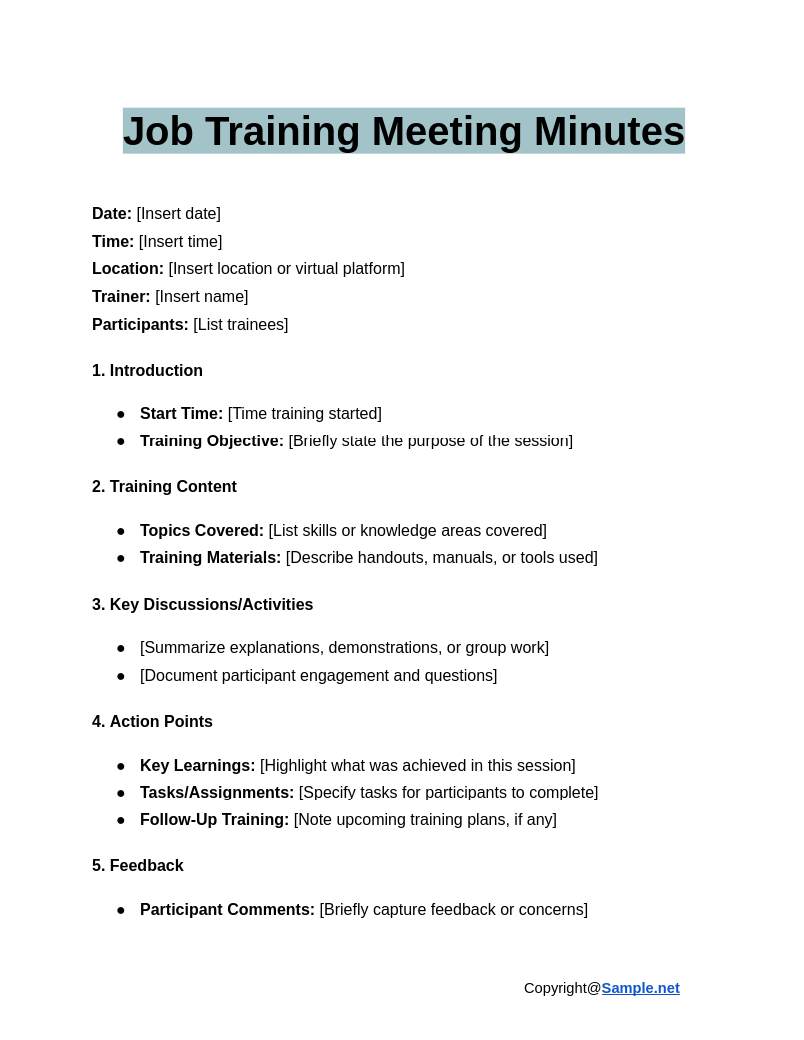
Job Training Meeting Minutes
download now -
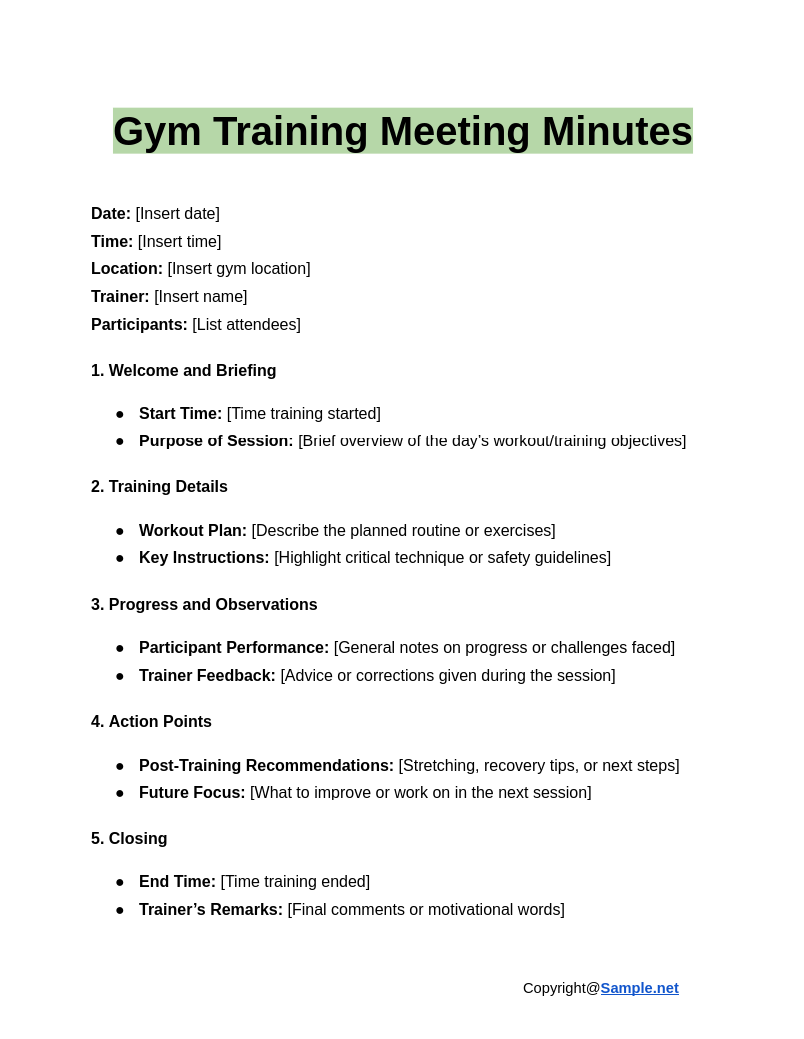
Gym Training Meeting Minutes
download now -
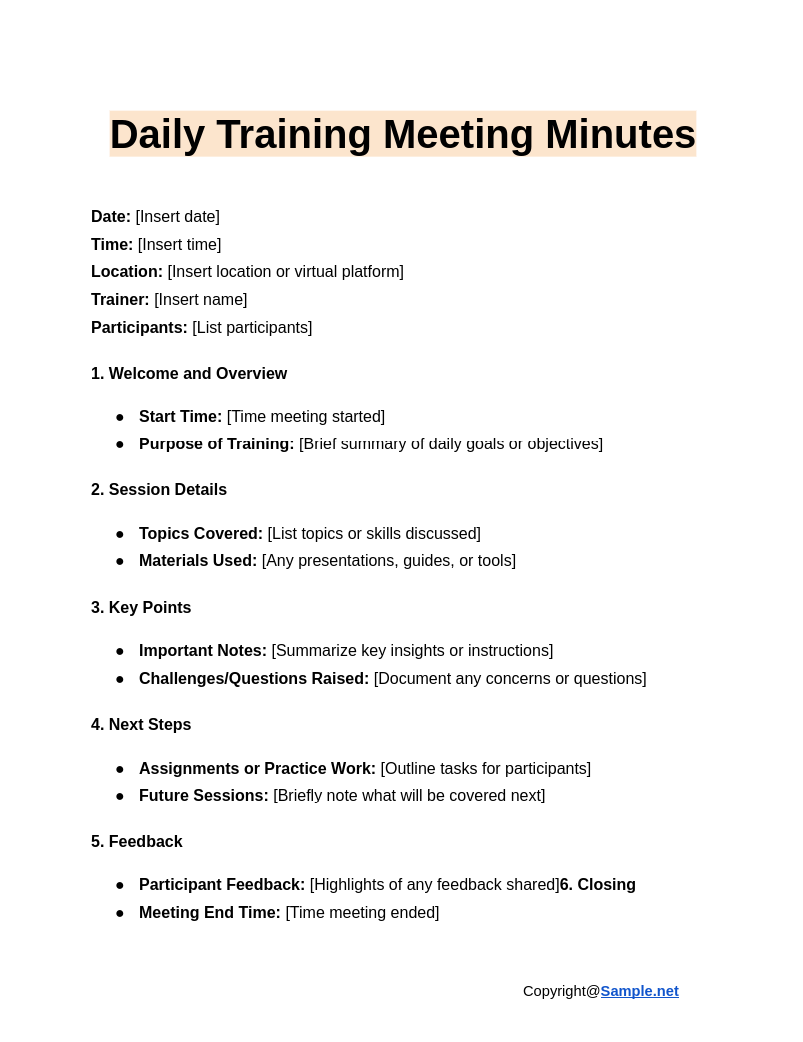
Daily Training Meeting Minutes
download now -
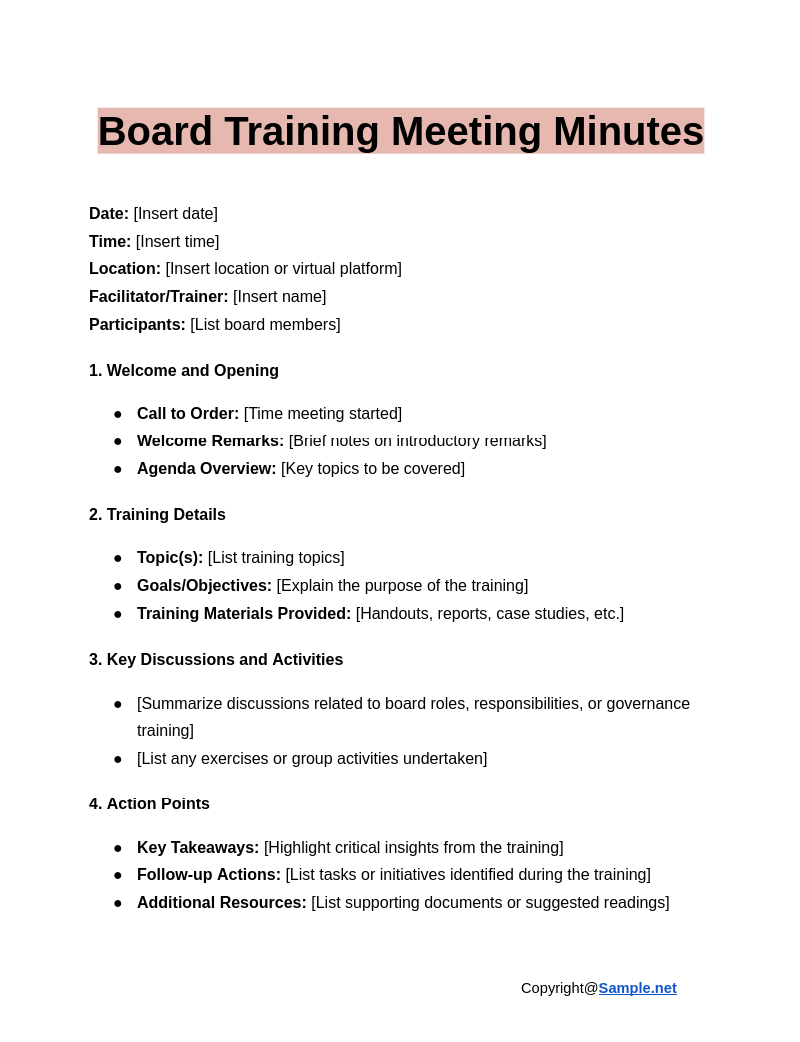
Board Training Meeting Minutes
download now -
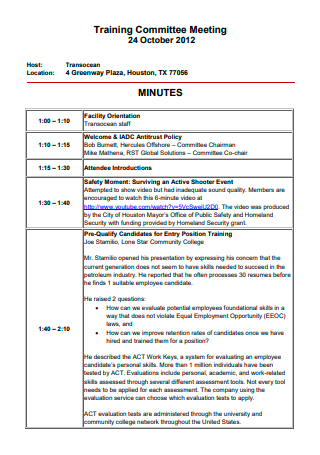
Training Committee Meeting Minutes
download now -
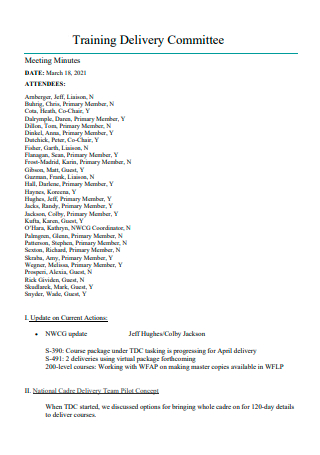
Training Delivery Committee Meeting Minutes
download now -
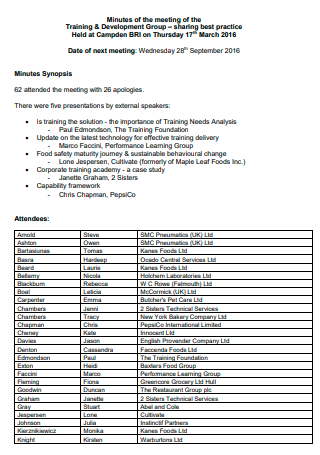
Training and Development Group Meeting Minutes
download now -
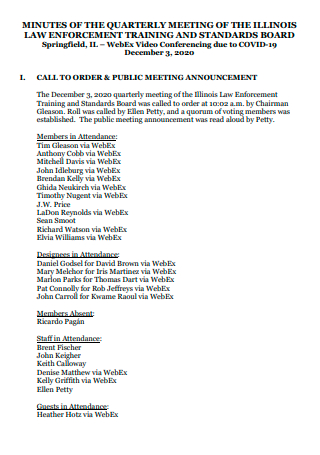
Law Enforcement Training Meeting Minutes
download now -
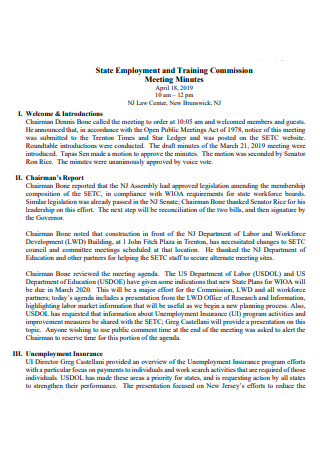
Employment and Training Meeting Minutes
download now -

Training Meeting Minutes Example
download now -
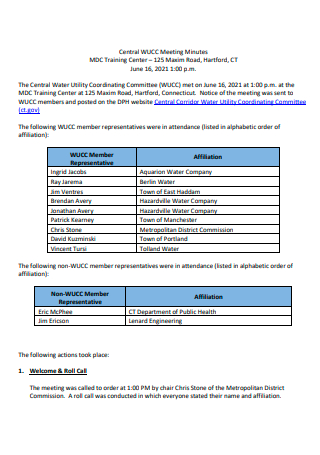
Training Center Meeting Minutes
download now -
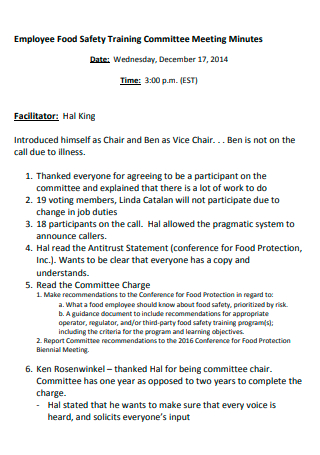
Employee Food Safety Training Committee Meeting Minutes
download now -
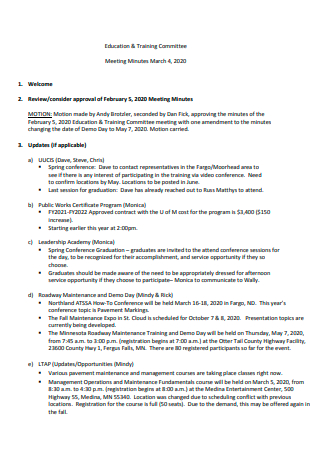
Education and Training Committee Meeting Minutes
download now -
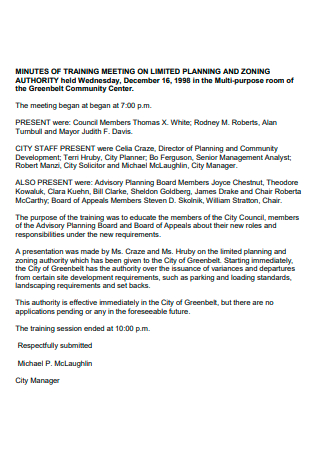
Training Meeting Minutes in PDF
download now -
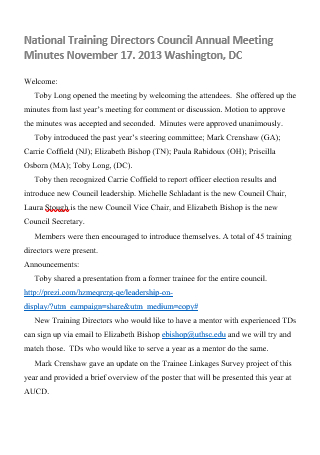
National Training Directors Council Meeting Minutes
download now
FREE Training Meeting Minutes s to Download
Training Meeting Minutes Format
Training Meeting Minutes Samples
What is Training Meeting Minutes?
Purposes of Training Meeting Minutes
How to Create Training Meeting Minutes
FAQs
What are meeting minutes for?
What constitutes an excellent meeting place?
What should my meeting minutes exclude?
What’s the difference between formal and informal training meeting minutes?
What are the legal implications of training meeting minutes?
How do you handle sensitive information in training meeting minutes?
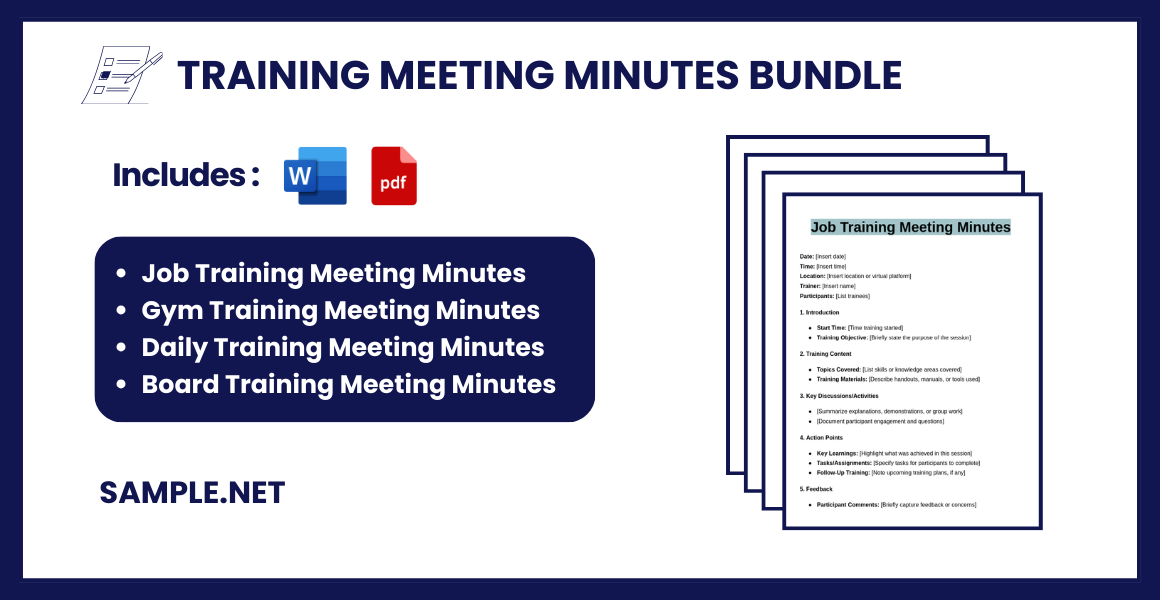
Download Training Meeting Minutes Bundle
Training Meeting Minutes Format
Training Meeting Minutes
Date: [Insert date]
Time: [Insert time]
Location: [Insert location or virtual platform]
Facilitator/Trainer: [Insert name]
Participants: [List names or attach attendance sheet]
1. Welcome and Opening
- Call to Order: [Time meeting started]
- Welcome Remarks: [Brief notes on introductory remarks]
- Agenda Overview: [Key topics to be covered]
2. Training Session Details
- Topic(s): [List training topics]
- Purpose/Goals: [Describe the purpose or learning objectives]
- Materials/Resources: [List materials provided (e.g., handouts, slides, videos, etc.)]
3. Key Discussions/Activities
- [Summarize discussions, activities, or group work]
- [Capture any Q&A or participant contributions]
4. Action Points
- Key Takeaways: [Summarize main points learned during training]
- Next Steps: [List any assignments, follow-ups, or actions for participants]
- Resources for Further Learning: [Mention any recommended materials or resources]
5. Feedback
- Participant Feedback: [Summarize participant comments or survey responses, if applicable]
- Trainer’s Remarks: [Notes from the trainer on session effectiveness]
6. Closing
- Meeting Adjourned: [Time meeting ended]
- Closing Remarks: [Brief notes on closing statements]
7. Prepared By
- Name: [Your Name]
- Role: [Your Role]
- Date: [Date of preparing the minutes]
What is Training Meeting Minutes?
Training meeting minutes are official records documenting the proceedings of a meeting related to training programs. They capture key points such as discussions, decisions, objectives, and assigned tasks. These minutes help ensure everyone involved has a clear understanding of the training’s direction and outcomes. By serving as a reference point, they prevent miscommunication and maintain focus on the organization’s training goals. Typically, they include the meeting’s date, attendees, agenda, and action points. You can also see more on Weekly Meeting Minutes.
Purposes of Training Meeting Minutes
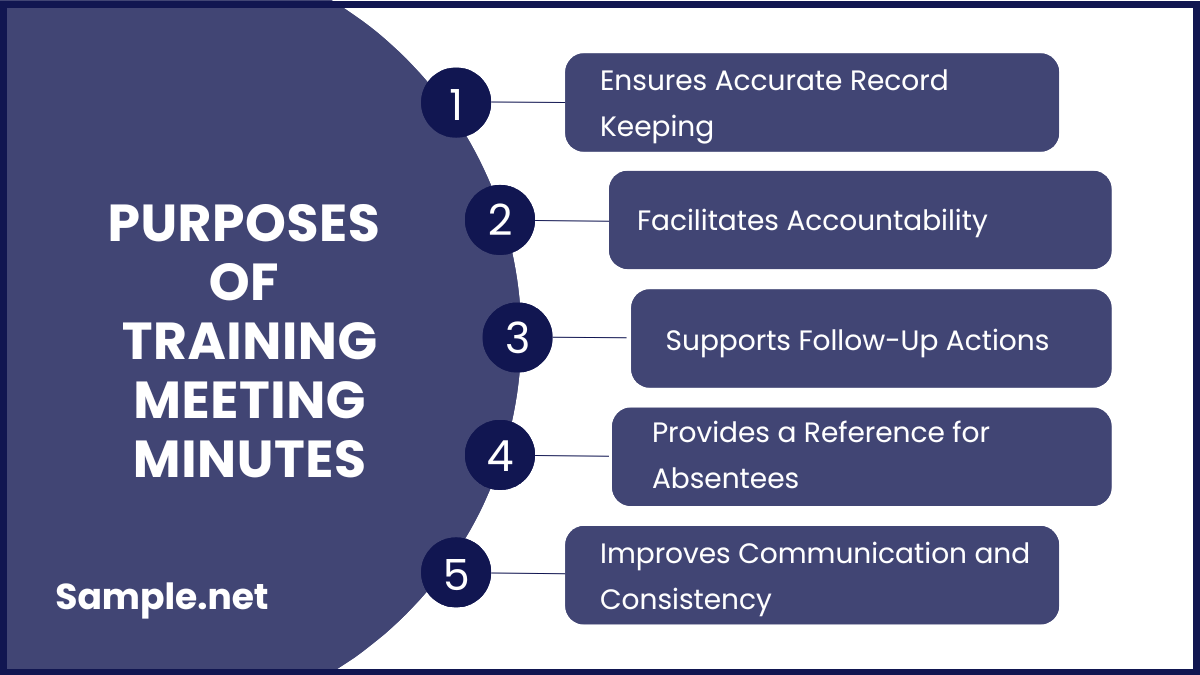
1. Ensures Accurate Record Keeping
Training meeting minutes serve as a reliable record of the discussions, decisions, and action items agreed upon during training sessions. This ensures that there is no ambiguity about what was discussed, helping participants recall essential details and supporting continuity in long-term projects.
2. Facilitates Accountability
By clearly documenting tasks, deadlines, and the individuals responsible for them, meeting minutes hold team members accountable for their commitments. This transparency ensures that everyone knows their roles and responsibilities, reducing the risk of misunderstandings or missed deadlines. You can also see more on Team Meeting Minutes.
3. Supports Follow-Up Actions
Detailed meeting minutes act as a roadmap for follow-up actions, ensuring that training objectives are implemented effectively. They help participants review what was discussed and track the progress of initiatives, making them an essential tool for monitoring and evaluation.
4. Provides a Reference for Absentees
For individuals who couldn’t attend the training meeting, the minutes provide a comprehensive summary of the discussions and outcomes. This keeps them informed, enabling them to contribute effectively to subsequent activities without missing critical context.
5. Improves Communication and Consistency
Training meeting minutes ensure that all participants are on the same page regarding decisions and objectives. They serve as a communication tool that eliminates discrepancies in interpretation, promoting consistency and aligning efforts toward shared goals. You can also see more on Research Meeting Minutes.
How to Create Training Meeting Minutes
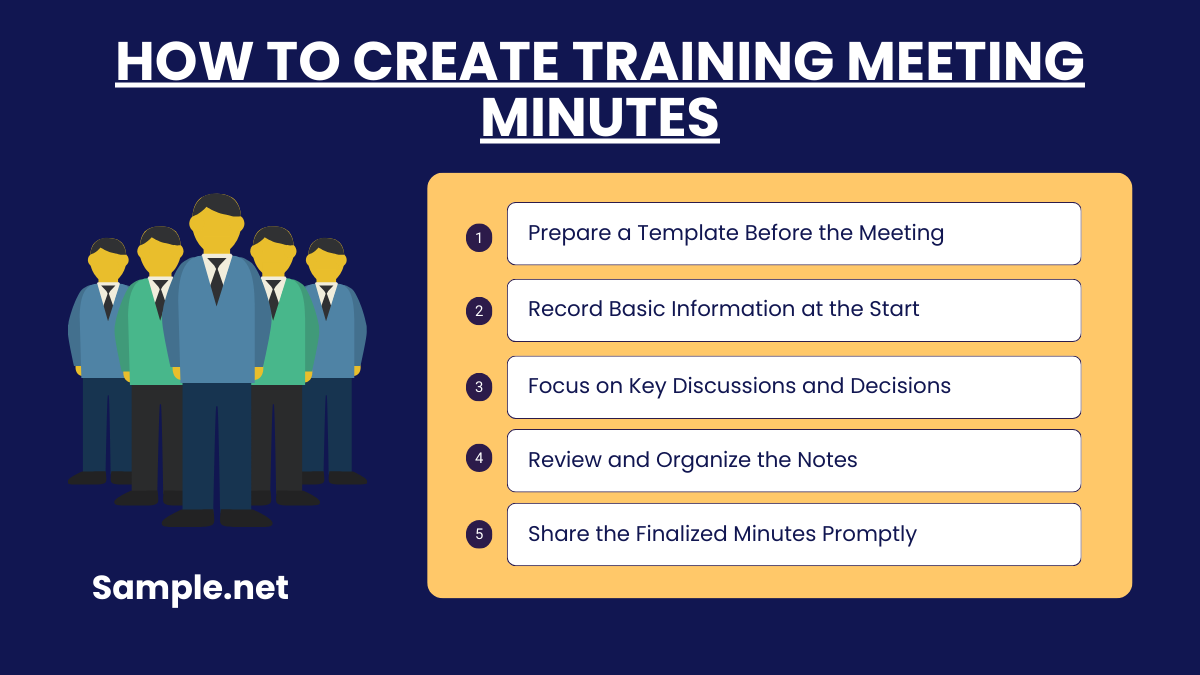
Step 1: Prepare a Template Before the Meeting
Before the meeting begins, create or select a template to guide your note-taking. This template should include sections for the meeting date, time, location, attendees, agenda items, key discussion points, decisions made, and action items. Preparing a template ensures you don’t miss important details and allows you to focus on capturing relevant information during the meeting.
Step 2: Record Basic Information at the Start
As the meeting starts, document essential details like the date, time, location, and names of attendees. Note the meeting’s purpose and the agenda items to provide context for the discussions. Confirming these details ensures that the minutes accurately reflect the meeting’s scope and participants. You can also see more on Operations Meeting Minutes.
Step 3: Focus on Key Discussions and Decisions
During the meeting, pay attention to significant discussions, conclusions, and action points. Avoid verbatim transcription; instead, summarize key points. Be clear about decisions made, tasks assigned, and deadlines set. For example, if an action item involves creating a training manual, document the task, the person responsible, and the deadline.
Step 4: Review and Organize the Notes
After the meeting, review your notes to ensure accuracy and completeness. Organize the content into sections like discussions, decisions, and next steps. Eliminate redundancies and use concise, professional language. Formatting the minutes clearly, such as with headings or bullet points, improves readability.
Step 5: Share the Finalized Minutes Promptly
Distribute the finalized meeting minutes to all attendees and relevant stakeholders within 24-48 hours. Ensure the minutes are easily accessible, either via email or a shared platform. Request feedback or corrections to address any inaccuracies. Prompt sharing ensures that all participants are aligned and can act on the documented action items efficiently. You can also see more on HR Meeting Minutes.
FAQs
What are meeting minutes for?
Meeting minutes are notes taken during a meeting to record what happened! Unlike a meeting agenda, it records the committee’s decisions and requests. Despite the team’s best efforts, they are not a minute-by-minute record, but rather a compilation of key information.
What constitutes an excellent meeting place?
A meeting is good for exchanging ideas and information since it brings together a variety of viewpoints. Meetings that successfully bring together a varied mix of motivated participants to share information, find resources and volunteers and set goals and action plans.
What should my meeting minutes exclude?
This additional information can help establish a rebuttable presumption that the behavior was reasonable, avoiding an IRS penalty. Because minutes are public records, it is vital to specify what should be withheld. Avoid direct quotations; even if the speaker isn’t identifiable, they can be.
What’s the difference between formal and informal training meeting minutes?
Formal training minutes are detailed records used in high-stakes or compliance-heavy meetings, often shared with stakeholders. They require a structured format and precise language. Informal meeting minutes, on the other hand, are more flexible and focus on capturing essential points for internal use. While formal minutes emphasize accuracy and comprehensiveness, informal notes prioritize speed and accessibility. You can also see more on Group Meeting Minutes.
What are the legal implications of training meeting minutes?
Training meeting minutes can have legal significance, especially in industries requiring compliance with training regulations. Accurate minutes provide evidence of training conducted and topics discussed. In disputes or audits, these records can demonstrate adherence to protocols. To ensure their legal value, they must be clear, factual, and signed by the chair or recorder of the meeting.
How do you handle sensitive information in training meeting minutes?
Sensitive information should be documented carefully and shared only with relevant stakeholders. Use clear, neutral language to describe discussions without compromising confidentiality. For highly sensitive topics, consider creating separate minutes or a summary version excluding restricted details. Always comply with organizational policies and data protection regulations. You can also see more on Administrative Meeting Minutes.
